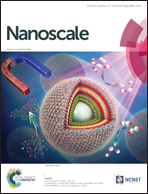Using a low-temperature carbon electrode for preparing hole-conductor-free perovskite heterojunction solar cells under high relative humidity†
Abstract
We demonstrate the application of a low-temperature carbon counter electrode with good flexibility and high conductivity in fabricating perovskite solar cells. A modified two-step method was used for the deposition of nanocrystalline CH3NH3PbI3 under high relative humidity. The carbon counter electrode was printed on a perovskite layer directly, with different sizes of graphite powder being employed. The interfacial charge transfer and transport in solar cells were investigated through photoluminescence and impedance measurements. We find that the existence of nano-graphite powder in the electrode has a noticeable influence on the back contact and cell performance. The prepared devices of hole-conductor-free perovskite heterojunction solar cells without encapsulation exhibit advantageous stability in air in the dark, with the optimal power conversion efficiency reaching 6.88%. This carbon counter electrode has the features of low-cost and low-temperature preparation, giving it potential for application in the large-scale flexible fabrication of perovskite solar cells in the future.


 Please wait while we load your content...
Please wait while we load your content...